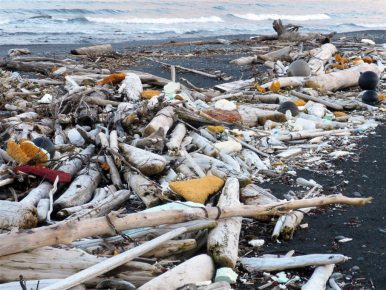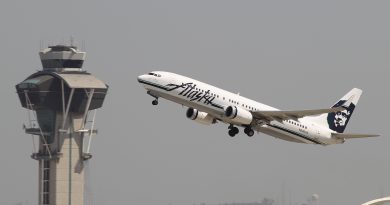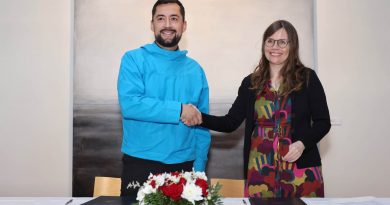Removing tsunami trash from remote Alaska beaches

Trash from Japan’s huge 2011 earthquake and tsunami is littering coastal beaches, including Alaska, but only limited cleanup efforts are gearing up during the favorable summer weather season.
“We’re already behind the curve on that,” said Chris Pallister, co-founder of Gulf of Alaska Keeper, which is using a $1 million state grant to clean up marine debris, much of which is from the tsunami, in an area around Prince William Sound.
Sharing in that grant will be the Island Trails Network out of Kodiak, and Airborne Technologies Inc., working in Southeast.
“We don’t get the money until sometime in July, and by the end of August you are already pushing your luck on the Gulf,” he said.
Montague and Kayak islands hard hit
The beaches there are thick with debris, he said.
“Montague Island has lot of debris, and Kayak (Island) was hit pretty hard as well. Other beaches have the same stuff, but not to the same degree,” he said.
State funding almost didn’t happen, but eventually a $1 million appropriation came through. Pallister credited the efforts of Rep. Alan Austerman, R-Kodiak, and Sen. Fred Dyson, R-Eagle River, for helping make that happen.
The trash is sometimes unsightly and sometimes dangerous, but cleanup efforts have been slow in materializing, with advocates facing skepticism over the value of a cleanup.
In Juneau earlier this year, U.S. Rep. Don Young questioned whether the debris was hurting anything, or was “just good beachcombing. Is it damaging anything, or does it just hurt the eyesight?” Young asked. “And if it hurts the eyesight, who’s seeing it?”
There are better uses for the cleanup money, he said.
“If it’s not causing environmental damage, would you rather spend the money on that or give the money to school kids,” he said.
What’s at risk is Alaska wildlife and residents, Pallister said.
Birds eating small pieces of plastic
The cleanup crews, which also involve federal, other state and private efforts are already seeing some debris being eaten by animals. That may increase, Pallister said, as urethane and Styrofoam gets weathered and breaks into smaller pieces.
“We know that birds are eating a lot of the foam, we see where they are pecking at it,” he said.
“And we do find animal scat out there with plastic in it, so we know some of them are eating the plastic,” he said.
The summer cleanup effort will begin to move that debris up and out of surf line so it can eventually be bagged and transported out.
Few of Alaska’s ocean beaches are accessible by vehicle, and many are difficult to even get to by boat. That means that helicopters have to be used to haul out the trash.
“A million dollars sounds like a lot of money, but not when helicopters run $2,000 an hour,” he said.
A Gulf of Alaska Keeper crew is already working in Prince William Sound, funded by the Exxon Valdez Oil Spill Trust Fund, which is cleaning up marine debris from the area hit by the 1989 spill.
It’s not exactly clear how much debris remains. The Alaska Department of Environmental Conservation has flown over beaches to survey then, said Jana Stewart, tsunami debris coordinator.
A National Oceanographic and Atmospheric Administration boat survey found much debris after the tsunami, according to DEC, but didn’t have baseline data with which to compare it.
For Pallister, who has been working on Gulf beaches for years, that wasn’t a problem. His group has been regularly cleaning certain beaches each year to measure how much additional debris has collected.
On 14 Prince William Sound beaches and three Kenai coast beaches, test plots provided post-tsunami comparisons “that shot up 100 fold — not 100 percent, 100 fold — on some beaches,” Pallister said. “That’s pretty revealing.”
Southeast Alaska beaches had less, though there were some “collector” beaches with disproportionately large amounts of debris, he said.
Rep. Bill Stoltze, R-Chugiak, supported adding additional $1 million to the state budget, money not requested by Gov. Sean Parnell.
“The potential environmental damages are just incalculable if we don’t address that,” he said.
Drums of acid, fuel
Pallister said cleanup workers are finding some potentially dangerous items, including drums of hydrochloric acid and an array of fuel drums. They found a dock made up of sealed barrels, too.
“They were marked ‘do not recycle, do not reuse, do not dispose: return to facility of origin,’ ” he said.
DEC was able to use control numbers on the drums to trace them back for safe disposal, he said.
“Those drums were never supposed to go anywhere but back to that facility, but somebody hid them in this dock. DEC came and got those, but that’s the kind of stuff we’re already running into,” he said.
The government of Japan has contributed millions to help with the cleanup, with Alaska hoping to get $1 million of that, Stewart said. They’ve already been promised $250,000, and Stewart said they would seek proposals on how to spend it.
Stewart’s temporary position as tsunami debris coordinator is new, and cleaning the state’s remote, inaccessible beaches was not a priority before the tsunami.
“It’s my understanding that the state has taken the position that marine debris is a federal responsibility,” she said.
NOAA has taken some responsibility for cleanups, but other states have their own programs, she said. And in many places, volunteer efforts are easily done because the beaches are readily accessible.
Contact Pat Forgey at pat(at)alaskadispatch.com



